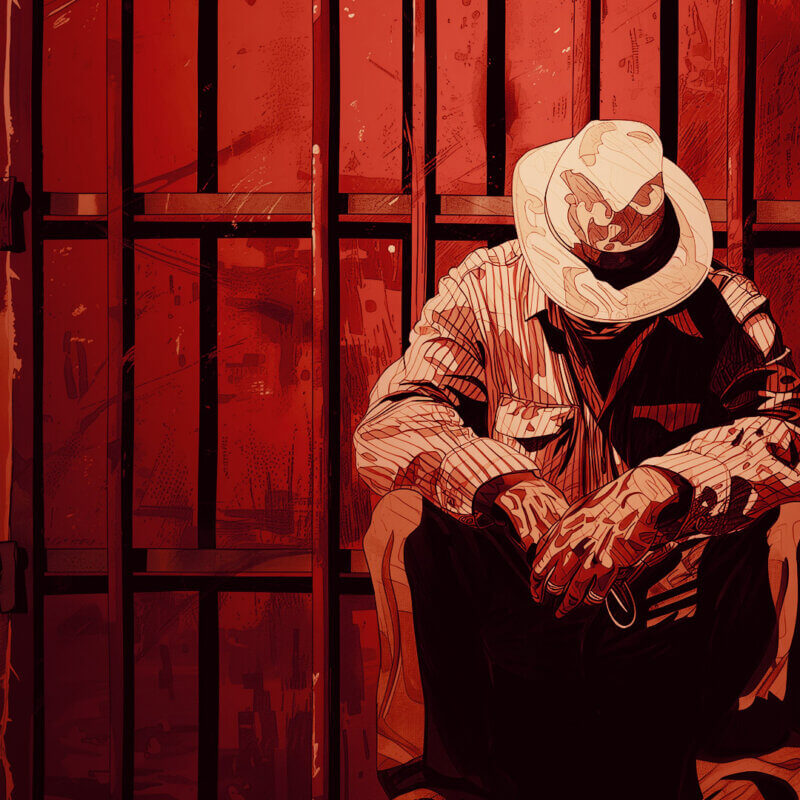

24-year-old Shannan Gilbert disappeared on May 1, 2010 after visiting a sex buyer in a gated Long Island community. The night of her disappearance, Gilbert had called 911, telling the operator, “They are trying to kill me.” She frantically knocked on house doors, panic-struck and pleading for help. But none came.
The Suffolk County Police Department’s missing-person search ended with discovery of four bodies, spread over a quarter of a mile near Ocean Parkway and Gilgo Beach. The women were wrapped in burlap sacks and buried in the sand and brush. Like Gilbert, all of the victims were actively in prostitution and had solicited clientele on Craigslist. These became known as the Gilgo Beach Murders.
But these serial killings aren’t just anomalies, rather they are indicative of a horrific demographic reality. Serial killers have long targeted prostituted women—from Jack the Ripper, an evasive murderer who terrorized prostituted women in the late 19th-century, to this most recent Long Island Serial Killer.
According to a recent study, 22 percent of confirmed U.S. serial murder victims between 1970 and 2009 were known prostituted women. And those numbers are climbing at an alarming rate. In the last decade alone, 43 percent of victims were prostituted. Considering that prostituted people make up just over 0.3 percent (42 million) of the US as a whole, those numbers are astonishing.
Studies conducted worldwide consistently show that those in prostitution suffer from physical and sexual assault at alarming levels. In fact, violence is intrinsic to prostitution itself.
Despite these statistics and news stories, our culture praises and encourages prostitution – claiming it is glamorous, empowering and liberating. But, the Gilgo Beach Murders are a mere case study of a much wider problem of violence against those in prostitution.
A Case Study of Violence: The Gilgo Beach Murders
The Gilgo Beach Murders were a series of killings between 1996 and 2011 in which the remains of 11 people were discovered in Gilgo Beach, located on the South Shore of Long Island, New York. Most of the known victims were prostituted who advertised on Craigslist. The killer became known as the Long Island Serial Killer.
The bodies of the four victims found in December 2010 became known as “The Gilgo Four.” In March and April 2011, six more sets of remains were found in Suffolk and Nassau counties.
The Gilgo Four
Maureen Brainard-Barnes
Maureen Brainard-Barnes of Norwich, Connecticut, was 25 years old and had two children when she disappeared. At the time, she was advertising prostitution on Craigslist. On the night of July 9, 2007, she called a friend in Connecticut and told her that she was planning on meeting a client outside of a Super 8 motel in Manhattan. She was never seen again.
Melissa Barthelemy
Melissa Barthelemy, 24, of Erie County, New York, went missing on July 12, 2009. She had been living in the Bronx in New York and prostituting through Craigslist. On the night she went missing, she met with a client, deposited $900 in her bank account, and attempted to call an old boyfriend, but did not get through. One week later, her teenage sister Amanda received a series of “vulgar, mocking, and insulting” calls from a man using Melissa Barthelemy’s cell phone. The caller asked if Amanda “was a whore like her sister.”
RELATED: Should Sex Work Be Legal?
The calls became increasingly disturbing and eventually culminated in the caller telling Amanda that her sister was dead and that he was going to “watch her rot.” Police traced some of the calls to Madison Square Garden, midtown Manhattan, and Massapequa, but were unable to determine who was making them.
Megan Waterman
Megan Waterman, 22, of South Portland, Maine, went missing on June 6, 2010, after placing advertisements on Craigslist as an escort. At the time of her disappearance, she was a victim of sex trafficking and she was staying at a motel in Hauppauge, New York, 15 miles northeast of Gilgo Beach.
Amber Lynn Costello
Amber Lynn Costello was 27 years old and lived in a small town ten miles north of Gilgo Beach. At the time of her disappearance she was actively prostituting and addicted to heroin. On September 2, 2010, she reportedly went to meet a stranger who had called her several times and offered $1,500 for her services.
More Victims Identified
Four more sets of remains were discovered on March 29 and April 4, 2011. All of the remains were found near Oak Beach and Gilgo Beach, within two miles of those found in December 2010. The newly discovered victims were Jessica Taylor, Valerie Mack, an unidentified woman designated “Jane Doe No. 3” or “Peaches”, and an unidentified toddler who was the daughter of “Peaches”.

Another two sets of remains were discovered on April 11, 2011, after the search expanded into Nassau County. They were found about one mile apart, approximately five miles west of where the Gilgo Four were discovered. One set of remains belonged to a victim now thought to be a transgender woman, designated “Asian Male.” The other remains were those of “Jane Doe No. 7”, now identified as a 34-year-old woman from Manhattan, Karen Vergata.
Vergata was publicly identified by the Suffolk County District Attorney in August 2023. Originally called “Jane Doe No. 7” and “Fire Island Jane Doe,” Karen Vergata’s partial remains were discovered on April 20, 1996. The remains found at Tobay Beach in Nassau County on April 11, 2011 helped identify the victim. Like the other victims, she was believed to have been prostituting when she disappeared in 1996.
Rex Andrew Heurermann
In July 2023, Rex Andrew Heuermann, a 59-year-old Nassau County resident and architect, was arrested in Midtown Manhattan and subsequently charged with three counts of first-degree murder, as well as three counts of the lesser charge of second-degree murder, related to the deaths of Melissa Barthelemy, Megan Waterman, and Amber Costello.
RELATED: Is “Sex Work” a Legitimate Job?
Authorities began to seriously consider Heuermann as a suspect in March 2022 after discovering that a Chevrolet Avalanche registered in his name had been linked to one of the killings by a witness. DNA testing indicated Heuermann as a potential match when hair found on the burlap wrappings of one of the bodies was compared to a sample gleaned from a pizza crust in a box he had discarded.
According to investigators, his cellphone records indicate he had been in contact with three of the four victims and an email account linked to Heuermann had conducted online searches of the investigation’s progress. Court records also indicated that he had searched the internet for “sadistic materials, child pornography, [and] images of the victims and their relatives.”
RELATED PODCAST:
On January 16, 2024, Rex Heurermann was charged with a fourth murder. He was linked to the death of 25-year-old Maureen Brainard-Barnes, who disappeared in 2007, through DNA and other evidence. The new court filings revealed that two phones were seized from Heurermann at the time of his arrest that had been used to contact prostituted women hundreds of times between 2020 and 2023.
Rex is also being investigated for a fifth murder. 29-year-old Carmen Vargas’ body was found dumped in Freeport, seven miles west of his home. Vargas’ family claims her death bares “too many similarities” to the Gilgo Four murders.
Heuermann has pleaded not guilty to all of the charges. The court date for the murder of Brainard-Barnes is set for February 6.
Prostitution is Inherently Violent Towards Women
Prostitution is often referred to as “the oldest profession” or “sex work” but in no other profession is there an expectation of violence towards the worker. It’s a system of exploitation and violence against women and children.
One survivor of prostitution shares, “In the process of selling my body, I was shot five times, stabbed more than 13 times, beaten unconscious several times, had my arm and nose broken, had two teeth knocked out, lost a child that I will never see again, was verbally abused, and spent countless days in jail.”
Unfortunately, her experience is not an anomaly. One of the largest studies conducted on prostitution, published in the Journal of Trauma Practice, surveyed 854 prostituted women in nine countries. It found that:
- 63% of women in prostitution were raped
- 71% were physically assaulted
- 68% met the criteria for post-traumatic stress disorder in the same range as treatment-seeking combat veterans and victims of state-organized torture.
A 2018 study revealed that 95% of prostituted women sustained traumatic head injuries along with acute or chronic symptoms from either being hit with objects or slammed into objects. And if the violence alone isn’t enough, the mortality rate of prostituted women is 240 times higher than that of the general population.
You may be asking yourself, “Why would any woman subject themselves to life-threatening situations like this on a daily basis?” Well, nearly all who enter prostitution do so from a position of vulnerability. Often they are homeless, orphaned, refugees, or suffer some form of social disadvantage. They have been repeatedly sold the lie that a woman’s primary value is her sex appeal and prostituting is actually a form of sexual liberation or empowerment.
RELATED: Is Prostitution a Choice?
But we must ask the question, is being reduced to your body parts, used for the sexual gratification of men and treated like trash really empowering? Prostitution is not glamorous or liberating, it is a form of slavery where the woman’s agency is completely stripped from her. This is why they become easy targets for men looking to exercise sadistic acts. Prostituted people are so utterly dehumanized that they are viewed as disposable in the eyes of the johns and killers alike.
At his sentencing hearing, Gary Ridgway, the so-called Green River Killer who was convicted of more than 48 murders, summed this up when he said, “I picked prostitutes as my victims because I hate most prostitutes… I also picked prostitutes because they were easy to pick up without being noticed. I knew that they would not be reported missing. I picked prostitutes because I thought I could kill as many of them as I wanted without getting caught.”
John Bittrolff was arrested in 2014 for the brutal murders of two prostituted women, 31-year-old Rita Tangredi and 20-year-old Colleen McNamee. The prosecutor on his case said, “Bittrolff picked these women because they were vulnerable. He picked them because he thought no one cared about them. But there were people who cared about these girls.”
Peter Sutcliffe (known as the Yorkshire Ripper) is believed to have murdered 13 women, some of whom were actively in prostitution, from 1975 to 1980 in Northern England.
Robert Hansen confessed to have murdered between 15 and 21 women in prostitution, near Anchorage, Alaska, between 1980 and 1983.
Joel Rifkin confessed to killing 17 prostituted women in the New York area between 1989 and 1993.
In December 2006, serial killer Steve Wright murdered five prostituted women in Ipswich, England.
Canadian serial killer Robert Pickton was convicted in 2007 of the murders of six prostituted women in Vancouver. In total, he confessed to the murder of 49 women.
We could go on…
So while the media wants to portray prostitution as glamorous and empowering, the stories of countless survivors and the news headlines of those brutally murdered by their clients paint a very different picture.
It’s time we stop elevating prostitution in our culture and acknowledge the truth: that it’s one of the most dangerous places to be a woman.
How You Can Help
Here at Exodus Cry, we actively reach out to women who are caught in trafficking and sexual exploitation—whether in strip clubs, on the streets, or online—and assist them in gaining freedom.
Our goal is to love them where they are, help them regain their sense of value, and provide them with practical resources so they can build beautiful new lives. We work with some of the nation’s top trauma therapy centers to provide hundreds of hours of life-changing therapy for these amazing women. You can help bring them freedom by giving below.
“The therapy sessions have been life-changing. They are… empowering, enabling me to navigate challenges I never imagined I could survive, let alone conquer. Your belief in my ability to heal has ignited a fire of hope within me, and your continued support gives me the strength to face each day with renewed courage and determination.” -Isabella, trafficking survivor & therapy recipient
Join the movement!
Subscribing to our email list connects you with the heartbeat of the movement to end commercial sexual exploitation.






